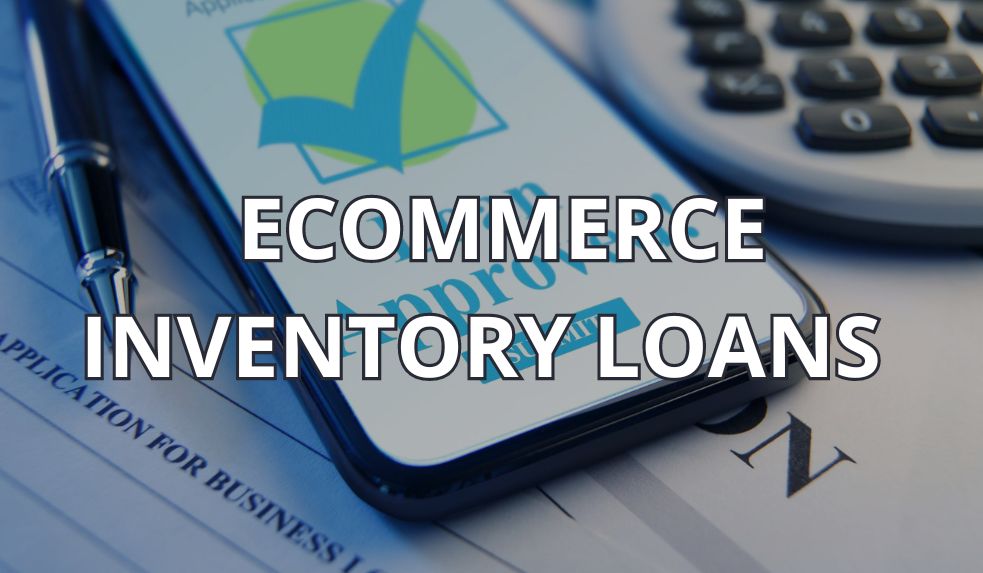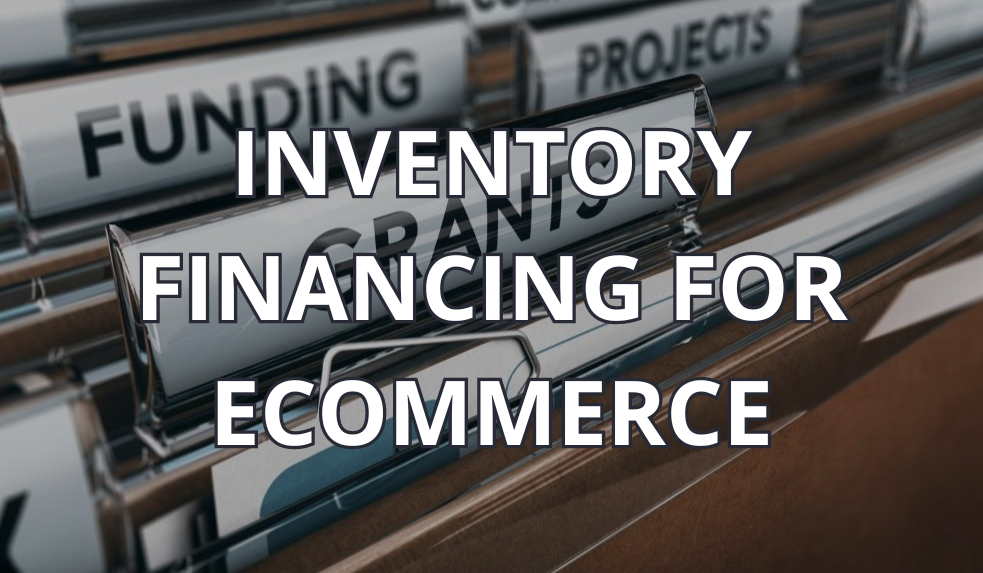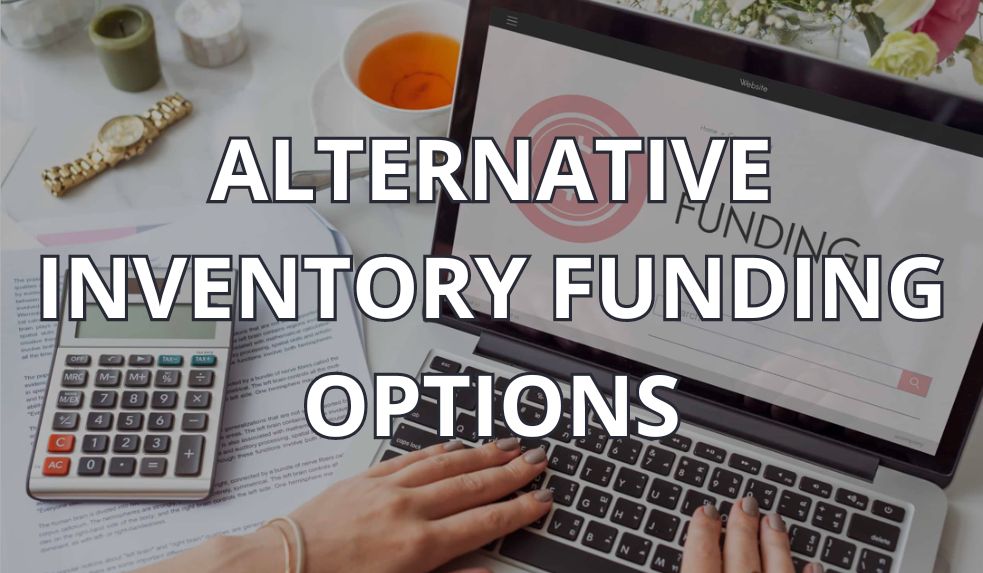Share this
Guide to Inventory Loans for Ecommerce
by Kyla Friel on Feb. 9, 2024

Inventory loans are a key financial tool for ecommerce businesses, used to acquire new inventory without threatening cash flow. Since ecommerce poses unique challenges, like changing customer demand, busy peak seasons, and the pressure to introduce new products, having the right amount of stock is crucial. But that can be costly – and inventory loans can help that up-front financial burden.
The most common types of traditional inventory loans are SBA loans, term loans, and lines of credit. Each of these financing options has its own advantages, but which option works best for your business depends on both eligibility and what kind of loan terms you’re looking for. This article examines the key features, eligibility criteria, and other must-knows of each inventory loan type so you can make a more informed decision for your ecommerce business.
How Ecommerce Inventory Loans Work
With inventory financing loans, the loan is specifically secured against the inventory itself. This means that the inventory your ecommerce business purchases or already holds serves as collateral for the loan. If your business fails to repay the loan according to the agreed-upon terms, the lender has the right to seize the inventory to cover the unpaid debt.
This type of loan is particularly attractive for businesses that hold significant amounts of inventory because it allows them to leverage existing assets to obtain financing. Inventory loans are commonly used to:
- Provide the necessary upfront capital to purchase additional inventory
- Maintain inventory levels during seasonal fluctuations
- Bulk purchase products to take advantage of discounts
- And expand product lines
The terms of an inventory loan often depend on the value of the inventory being used as collateral. Lenders typically require an appraisal of the inventory to determine its value and may lend a percentage of that value. This approach helps manage the lender's risk while providing businesses with access to capital based on the worth of tangible goods rather than solely on credit history or cash flow projections.
Ecommerce businesses looking to finance their inventory have several options, including SBA loans, bank loans, and lines of credit, each offering distinct pros and cons.
Small Business Administration (SBA) loans are attractive for their government backing, which can mean lower interest rates and longer repayment terms. The SBA's partial guarantee to the lender means that businesses that might not qualify for a traditional bank loan might have better chances with an SBA loan.
Traditional bank loans offer a lump sum of money with a fixed interest rate and repayment period. These are well-suited for businesses with a clear, one-time inventory purchase in mind. The predictability of a bank loan can make financial planning easier, but it might require more collateral or a stronger credit history than SBA loans.
Lines of credit offer the most flexibility. They allow businesses to draw funds up to a certain limit as needed. This can be beneficial for ecommerce businesses that experience fluctuating demand or want to take advantage of sudden market opportunities without the lengthy application process of more traditional loans. However, lines of credit may come with higher interest rates and fees, depending on the lender.
Choosing between these financing options depends on the specific needs and circumstances of your business. SBA loans might be the go-to for those looking for stability and support in growth phases. Traditional bank loans could appeal to those with a one-off, significant inventory need. And lines of credit might best serve businesses seeking flexibility to manage ongoing or fluctuating inventory requirements.
We explore each of these types of inventory financing in detail below to help you decide which type of inventory loan is best suited for your ecommerce business.
You can also learn more about traditional inventory financing as well as other alternative inventory funding options in our free Inventory Financing Guide.
Download our Inventory Financing Guide
SBA Inventory Loans
SBA loans are small business loans guaranteed by the Small Business Administration, a U.S. government agency. However, The Small Business Administration doesn't provide loans directly to small businesses. Instead, it establishes guidelines for loans issued by its partners, including banks, credit unions, community development organizations, and microlending institutions.
By guaranteeing a portion of these loans, the SBA reduces the risk for these lenders, making them more inclined to lend to small businesses. The SBA regulates the maximum loan amounts and ensures lower interest rates than those typically offered by banks. This arrangement is beneficial for businesses unable to secure a traditional inventory loan.
Types of SBA Loans for Ecommerce Businesses
The most popular types of SBA funding that ecommerce businesses can use as an inventory loan are:
- 7(a) Loan Program: This is the SBA's most common loan program and offers the greatest flexibility in terms of use, making it ideal for ecommerce businesses looking to purchase inventory or other business needs. The 7(a) program offers loans up to $5 million, with repayment terms of up to 10 years for working capital loans and up to 25 years for fixed assets.
- Microloan Program: Specifically designed for small businesses, the SBA Microloan program offers loans up to $50,000. This program can be particularly suitable for new or smaller ecommerce businesses needing a modest amount of funding to purchase inventory or for other capital needs. The repayment terms vary according to the loan amount, planned use of funds, and the borrower's needs, but the maximum term allowed is six years.
Key Features of SBA Loans
- Lower Down Payments: Compared to traditional loans, SBA loans often require smaller down payments. This can be 10% to 30% depending on the loan type.
- Longer Repayment Terms: They typically offer longer repayment terms, which can be beneficial for cash flow management.
- Competitive Interest Rates: Interest rates for SBA loans are usually competitive, though they vary based on the loan amount and the borrower's credit history. While each lender will negotiate their interest rates, they cannot surpass the SBA interest rate maximums which are determined by loan amount and repayment length.
- Collateral: For larger loans, especially those over $350,000, collateral might be required. Ecommerce businesses often use inventory as collateral.
Eligibility Criteria
According to the Small Business Administration, to be eligible for an SBA loan, your business must:
- Be operating as a for-profit business
- Be located in the United States of America
- Fit the SBA size requirements for small business
- Not operate in an ineligible industry (including gambling, real estate, lending institutions, and nonprofits, among others)
- Be unable to obtain the desired credit through non-government sources
- Prove creditworthiness and a reasonable ability to repay the loan
The most common reasons an SBA loan application might be denied are poor credit, an excess of existing debt, or a lack of sufficient collateral.
SBA Loan Application Process
- Locate SBA Lenders: Not all banks or financial institutions offer SBA loans. Use the SBA's Lender Match tool or contact banks directly to find SBA-approved lenders.
- Compare Terms: Different lenders might offer slightly different terms on their SBA loans, so it's advisable to shop around.
- Prepare Documentation: This may include business and personal financial statements, tax returns, business plans, and details about how you intend to use the loan.
- Application Submission: The lender will guide you through the application process and submission.
- Approval and Funding Time: Approval times can vary, but it usually takes between 30 and 90 days from submission to receive the funding if approved.
Documentation Needed for an SBA Inventory Loan
- Personal Background Statement: This document includes personal information, such as previous addresses, names used, criminal record, educational background, etc.
- Borrower Information (SBA Form 1919): This form gathers general information about the borrower, including details about the business, its ownership, and any relations with other businesses.
- Personal Financial Statement (SBA Form 413): This form details the personal financial status of the borrower, including assets, liabilities, income, and expenses. Personal Tax Returns: Copies of the most recent personal income tax returns, usually required for the last two to three years.
- Personal Credit Report & Score: Small businesses typically don’t have enough of a borrowing history for a business credit report, so the borrower’s personal credit report is required. While the SBA itself doesn’t have a minimum credit score requirement, some lenders might. Usually, borrowers with a personal credit score of 680 and higher are more likely to be approved.
- Professional Resume: A resume for each principal in the business, showing relevant business experience and capabilities.
- Business Plan: A detailed plan outlining the business model, market analysis, marketing strategy, and financial projections. For an ecommerce company, it might also address online operations, logistics, and digital marketing strategies.
- Use of Loan: A specific breakdown of how the loan funds will be utilized. Make sure to review the use requirements for each type of SBA loan to ensure you’re applying for the right type of loan for your intended use.
- Balance Sheets: The business's balance sheets for the last few years, which list the business’s assets, liabilities, and equity. This should include a current balance sheet updated within the last 60 days.
- Profit & Loss Statements (P&L): A P&L shows the company's revenues, costs, and expenses over a period. SBA lenders typically request a current year-to-date profit and loss statement, which should be updated within the past 60 days, along with complete P&L statements from the previous three fiscal years.
- Debt Schedule: A comprehensive list of all current business debts, including amounts owed, monthly payments, maturity dates, and the nature of the debts.
- Business Income Tax Returns and Bank Statements: Business tax returns for the past two to three years and recent bank statements to provide insight into the financial health and cash flow of the business.
- Collateral: Documentation of assets that will be used as collateral for the loan.
- Legal Documents: Any legal documents pertinent to the business, such as articles of incorporation, leases, or business licenses.
Should You Use an SBA Loan for Inventory Financing?
Choosing an SBA loan over a traditional bank loan or line of credit comes down to your specific business situation. Factors like the need for lower down payments, longer repayment periods, competitive interest rates, a lack of business credit history, or having been previously turned down by traditional lenders might tilt the balance in favor of an SBA loan. If your business fits the criteria, then SBA loans are worth looking into.
Bank Loans
These types of inventory loans are direct financial borrowings from a banking institution. Unlike SBA loans, they are not guaranteed by the government. These loans can be used for various business needs, including purchasing inventory, expanding operations, or as working capital for ecommerce businesses.
This type of financing is offered in the form of “term loans,” where a lump sum is borrowed and paid back with interest over a fixed period. These inventory loans are most suitable for large or one-off inventory purchases.
Banks, credit unions, and online lenders offer term loans for ecommerce businesses looking to fund inventory purchases. While banks and credit unions usually offer the best rates on these types of loans, it might be harder to qualify with these institutions due to the higher risk associated with inventory as collateral. Online lenders often offer more flexible qualification criteria, but that can also come with higher interest rates or a shorter repayment period.
Key Features of Bank Loans
- Interest Rates: Can be fixed or variable. Rates depend on the business's credit history and market conditions.
- Repayment Terms: Vary based on the type of loan and the lending institution. Term loans might have longer repayment periods, while short-term loans are quicker to pay off.
- Collateral Requirements: Collateral is usually required for larger inventory loans. This can include business assets, inventory, or personal assets.
- Fees and Penalties: Be aware of origination fees, processing fees, and potential prepayment penalties.
Eligibility Criteria
- Time in Business: Lenders typically look for businesses that have been operating for at least two years. This requirement helps ensure that the business has established a stable operational history.
- Business Revenue: A specific annual revenue threshold is often required to qualify for a traditional bank term loan. This amount varies among lenders but is used to demonstrate that the business consistently generates enough income to manage additional debt.
- Credit Score: The credit histories of both the business and its owners will be assessed. High credit scores are preferred, and it might be difficult to secure a loan without one.
Documentation Needed for a Bank Inventory Loan
- Business Plan: Detailed document outlining your business strategy, market analysis, financial projections, and specific plans for the use of the loan funds, including how it will help grow or sustain your inventory.
- Debt Schedule: A list of all current business debts and obligations.
- Financial Statements: Includes balance sheets, income statements (profit and loss accounts), and cash flow statements for the past few years to demonstrate the financial health of your business.
- Inventory List: Detailed list of current inventory and the inventory to be purchased with the loan funds, including the value of the inventory which will act as collateral.
- Business Tax Returns: Typically, the last two to three years of tax returns to verify the business's financial history and performance.
- Personal Tax Returns: From the business owners, to assess their financial reliability and backing in case the business cannot fulfill its repayment obligations.
- Credit Reports: Both personal and business credit reports are often required to evaluate creditworthiness.
- Collateral Documentation: Detailed information on the assets being used as collateral, including any existing liens on those assets.
- Legal Documents: Including business licenses, registration documents, leases, or any contracts that have significant financial implications for the business.
- Bank Statements: Recent business bank statements to provide a snapshot of the company's current financial activity and liquidity.
Should You Use a Bank Loan for Inventory Financing?
If your ecommerce business requires a substantial lump sum for a clear, one-time inventory purchase – perhaps to capitalize on a bulk buying opportunity or to stock up for a predictable seasonal surge – a bank loan may be the right choice. Bank loans are particularly suited for businesses with established credit histories and strong financials. Their fixed interest rates and repayment schedules can simplify financial planning but may be harder to qualify for if you’re a new or smaller business.
Line of Credit as Inventory Loan
A line of credit (LOC) is a flexible loan from a bank or other financial institution, like a credit union or online lender. Unlike a traditional loan, a line of credit operates similarly to a credit card, where the borrower has access to a set amount of funds which they can draw upon as needed.
For ecommerce businesses, LOCs are often used for purchasing inventory, managing cash flow, and addressing short-term financial needs on an ongoing basis. However, the loan amount for an inventory line of credit can be smaller than what is offered with a traditional term loan. Depending on the lender, you might also be required to sign a personal guarantee on top of providing collateral.
Key Features of Lines of Credit
- Flexibility: Funds can be drawn as needed, making it a flexible funding option for fluctuating inventory needs. You are able to carry a balance that will accrue interest until it is paid down, but you can continue to borrow from the LOC as long as you have room left on it.
- Interest Rates: Generally, LOCs have higher interest rates than traditional loans. Rates can be fixed or variable, depending on the lender. Some lenders might also charge annual or inactivity fees. However, you only pay interest on the amount you’ve used, and not the full amount available on the LOC.
- Repayment Terms: These can vary widely. Some lenders require monthly interest payments with a balloon payment at the end, while others have regular amortization schedules.
- Credit Limits: Limits can vary significantly depending on the lender, the borrower's credit history, and the value of the collateral used, but are often lower than bank term loans.
Eligibility Criteria
- Time in Business: Lenders often require that a business has been operating for a minimum period, usually at least one to two years. This helps lenders assess the business's track record and stability.
- Business Revenue: There's usually a minimum annual or monthly revenue requirement to qualify for a line of credit. This threshold varies among lenders, but there are some that have specific LOCs for new businesses with lower revenue.
- Credit Score: Both the personal credit scores of the business owners and the business credit score are important. There are LOC lenders out there that cater to businesses with a lack of credit history or a lower credit score, but these loans might come with higher interest rates.
- Collateral: For secured lines of credit, lenders may require collateral, which can include inventory, equipment, accounts receivable, or other business assets. The value and type of collateral will be assessed and can influence the amount of credit extended.
Documentation Needed for a Line of Credit Inventory Loan
- Business Plan: While perhaps not as detailed regarding the specific use of funds as with a term loan, a plan showing how the line of credit will support your ecommerce inventory management is helpful.
- Financial Statements: Similar to a term loan, these documents are crucial for demonstrating the business’s financial health and ability to manage debt.
- Inventory Management Plan: Documentation showing how inventory levels fluctuate and how the line of credit will be used to manage these fluctuations. This could include your business’s inventory turnover ratio.
- Business and Personal Tax Returns: Essential for assessing the financial history and stability of both the business and its owners.
- Credit Reports: Needed to assess the creditworthiness of the business and its principal owners.
- Collateral Documentation: Information on assets to be used as collateral, which may include not only inventory but also other assets, depending on the lender's requirements.
- Legal Documents: Documents proving the legal status of the business, ownership, and operational authority, as well as any leases or contracts.
- Bank Statements: To provide evidence of current financial operations and health.
Should You Use a Line of Credit for Inventory Financing?
A line of credit might be more suitable for inventory financing if your ecommerce business experiences fluctuating demand or if you're looking for flexibility in managing inventory levels without committing to a long-term loan.
Also consider a line of credit if your ecommerce business sells a wide range of products, with some items significantly more popular during certain times of the year. Demand can be hard to predict, and you might find yourself needing to quickly restock popular items or invest in new products to meet changing customer interests. A line of credit gives you the flexibility to manage these variable inventory needs efficiently. This ensures you can always meet customer demand without the need for a large, one-time loan.
Inventory Management with a 3PL
Finding the right financing solution is crucial for expanding your ecommerce business. Adequate funding for additional inventory and launching new products is essential for scaling up, reaching more customers, and meeting the demands of your ecommerce orders.
Juggling ecommerce inventory management along with marketing your products and managing day-to-day operations can be challenging. That's where partnering with a leading 3PL provider like Shipfusion comes into play.
Partnering with Shipfusion for your ecommerce order fulfillment means gaining access to our proprietary inventory management software. Our tech and integrations instantly enable seamless synchronization of your inventory data across all sales channels in real-time, whether you're selling on Shopify, Amazon, TikTok Shop, or any other ecommerce platform.
From the moment inventory arrives at our warehouse until it's shipped to your customer, every item is expertly tracked. This means you can stop worrying about inventory accuracy and dedicate more time to growing your business. If you're ready to shift your focus from inventory management to expanding your business, reach out to one of our fulfillment specialists today.
Share this
You May Also Like
These Related Articles

Complete Ecommerce Inventory Financing Guide For 2024

Guide to Alternative Inventory Funding Options for Ecommerce

Customer Financing: Offer Buy Now Pay Later as an Ecommerce Business
- April 2025 (9)
- March 2025 (26)
- February 2025 (26)
- January 2025 (37)
- December 2024 (16)
- November 2024 (23)
- October 2024 (22)
- September 2024 (27)
- August 2024 (9)
- July 2024 (8)
- June 2024 (5)
- May 2024 (8)
- April 2024 (8)
- March 2024 (6)
- February 2024 (6)
- January 2024 (5)
- December 2023 (3)
- November 2023 (3)
- October 2023 (5)
- September 2023 (4)
- August 2023 (2)
- July 2023 (1)
- June 2023 (4)
- March 2023 (2)
- October 2022 (1)
- September 2022 (5)
- August 2022 (4)
- July 2022 (7)
- June 2022 (4)
- May 2022 (4)
- April 2022 (6)
- March 2022 (2)
- February 2022 (1)
- January 2022 (3)
- December 2021 (2)
- November 2021 (4)
- October 2021 (2)
- September 2021 (5)
- August 2021 (4)
- July 2021 (4)
- June 2021 (3)
- May 2021 (2)
- April 2021 (3)
- March 2021 (3)
- February 2021 (3)
- January 2021 (2)
- December 2020 (4)
- November 2020 (2)
- October 2020 (4)
- September 2020 (2)
- July 2020 (5)
- June 2020 (4)
- May 2020 (2)
- April 2020 (2)
- March 2020 (4)
- February 2020 (1)
- December 2019 (1)
- May 2018 (1)
- March 2018 (2)
- February 2018 (3)
- January 2018 (3)
- November 2017 (3)
- July 2017 (4)
- March 2017 (3)
- February 2017 (5)
- January 2017 (3)
- December 2016 (4)
- November 2016 (6)
- October 2016 (6)
- October 2015 (1)
- September 2015 (1)
- June 2015 (3)
- May 2015 (3)
- August 2014 (1)
- July 2014 (1)
- March 2014 (1)
- February 2014 (1)